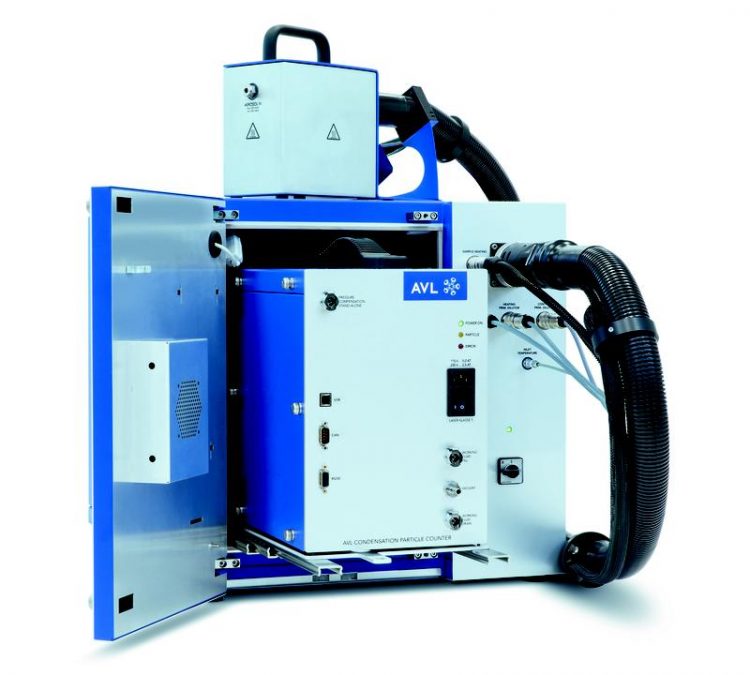Emission measurement: High-precision nanoparticle sensor developed

Pic 1: The newly developed APCplus exhaust gas analyser has 20 per cent more power in order to count tiny particles faster and more accurately. ©AVL
Diameter of under 0.2 micrometres
Reducing atmospheric particulate matter, including the nanoparticles emitted from internal combustion engines, is in the public interest. A team of researchers from CTR Carinthian Tech Research in Villach and AVL List GmbH in Graz has therefore developed a high-precision optical sensor that can even detect tiny particles with a diameter of under 0.2 micrometres (µm).
The size is particularly important because the smaller the particles are, the more harmful they are to health. A tailored, simulation-aided design process has enabled the particle counter to accurately detect the smallest of pollutants and measure them at three times the speed. At the same time, researchers improved the system’s overall stability and control.
Applications for this new development include AVL’s APCplus exhaust analysis product range, which has been on the market since autumn 2016. The device is used in automotive development, monitoring and exhaust gas analysis.
Integrative system modelling and co-design
Of all airborne pollutants, nanoparticles below 200 nanometres (nm) in particular are detected. It is a size that is exceptionally difficult to measure. Detecting the actual particulate emissions therefore requires accurate and reliable sensors. This involves counting the nanoparticles in the air or exhaust gas individually and not as total parameters.
To do so, the nanoparticles are fed into a supersaturated atmosphere. In it they act as condensation nuclei and create an aerosol stream where the droplets can be counted individually. This requires the interaction between the thermal, physical and chemical processes to be carefully managed in order to ensure reliable particle detection.
“We created a comprehensive 3D simulation model on the computer and compared it with experimental data. The challenge lay in the complexity of the measurement principle and mutual dependencies. Only when you research and develop extensively and systematically can the overall system be improved,” says Martin Kraft, CTR’s head of research in photonic system engineering.
More accurate and faster detection
Tristan Reinisch, Product Development Team Leader at AVL, believes research collaboration ultimately results in added value for users: “The nanoparticle sensor’s power has increased by 20 per cent. We thus achieve a high level of selectivity with reference to the nanoparticle diameter and obtain faster count results.” The APCplus nanoparticle counter was developed and produced in Austria. Other developments of this kind are planned.
Strategic research partnership
Research cooperation between AVL and CTR is planned in the long term. Initial basic research started in the first phase (2008-2014) of the COMET centre of excellence programme and is carrying on under the current programme (2015-2022) dedicated to ASSIC (Austrian Smart Systems Integration Research Center).
About CTR Carinthian Tech Research
CTR is the largest non-academic research centre in Carinthia and ranks among Austria’s leading research institutes in the area of smart sensors and systems integration. Its task and objective is to develop innovative sensor technologies (photonic, sensor, micro and nano systems as well as assembly, packaging and integration technologies) for industry and to integrate them in concrete applications. CTR research will therefore play a role in meeting society’s great challenges, such as energy, mobility, health, climate and security.
Services range from feasibility studies, simulations and tests to prototyping and system design. Established in 1997, CTR has filed over 80 patents and conducts research in regional, national and international projects. Research partners include ABB, AT&S, AVL List, Infineon Technologies, Lam Research, EPCOS, Philips Austria, Siemens, TIPS Messtechnik, the European Space Agency (ESA), Vienna University of Technology, Carinthia University of Applied Sciences, Klagenfurt University and Lausanne EPFL.
http://Further links:
http://www.ctr.at/en
http://www.avl.com/-/APCplus-AVL-Particle-Counter
Media Contact
All latest news from the category: Physics and Astronomy
This area deals with the fundamental laws and building blocks of nature and how they interact, the properties and the behavior of matter, and research into space and time and their structures.
innovations-report provides in-depth reports and articles on subjects such as astrophysics, laser technologies, nuclear, quantum, particle and solid-state physics, nanotechnologies, planetary research and findings (Mars, Venus) and developments related to the Hubble Telescope.
Newest articles

Durable, Efficient, Sustainable: The Rise of Cerium Oxide Thermal Switches
Groundbreaking cerium oxide-based thermal switches achieve remarkable performance, transforming heat flow control with sustainable and efficient technology. Cerium Oxide-Based Thermal Switches Revolutionize Heat Flow Control Thermal switches, which electrically control…

How Industrial Robots are Reducing Emissions in Global Manufacturing
A new study explores the intersection of industrial automation and environmental sustainability, focusing on the role of industrial robots in reducing the carbon intensity of manufacturing exports. The research demonstrates…

Patients Can Heal Through Precise, Personalized Bioceramic Grafts
A recent review is transforming the landscape of craniomaxillofacial bone regeneration with the introduction of personalized bioceramic grafts. This pioneering research explores the fabrication and clinical potential of synthetic grafts…



